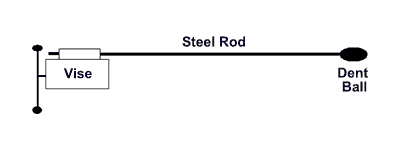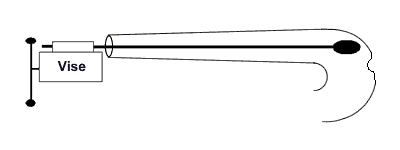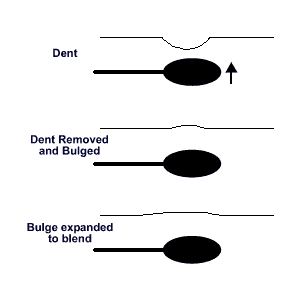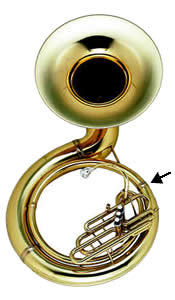The Dent Eraser
By Curt Altarac
[Reprinted from the TubaNews]
The Dent Eraser is the amazing magnetic dent removal system for use on brass bodied musical instruments. Dents that would otherwise have required many hours of labor to remove can now be repaired in minutes with this tool. The patented Dent Eraser works through the use of rare earth magnets and precision manufactured steel balls to substantially simplify musical instrument dent repair.
Traditionally, dents were removed from brass instruments using a steel ball threaded onto a rod. The steel rod and ball are inserted into the bore of the instrument up to the point of damage. Pressure is exerted downward on the instrument while the rod is held firmly in a vise. The dent in the instrument is stretched, and the body of the instrument is brought as close to its original shape as possible.

Fig 1. Dent Rod in vise

Fig 2. Dent Rod with downward pressure
This method often requires a tremendous amount of time and skill to remove dents. Repair shops that do dent work on brass bodied instruments require many shapes of rods and balls to remove difficult to reach dents. Some dents are so difficult to reach that the instrument must be disassembled to remove them. This results in further cosmetic damage to the instrument and more time spent doing the repair.

Fig 3. Dent out of reach

Fig. 4 Bent rod to reach dent
A major drawback to this method of dent removal is it's tendency to harden the brass of the instrument. When an instrument is dented, that portion of the brass body is stretched. If a steel ball on a rod is used to press the dent up from inside the bore, only the skill of the technician stops the ball from stretching the brass too far up from the inside of the instrument. Often the dent appears to be removed but actually becomes a bulge in the body. The area around the bulge is then expanded so the bulge is not visible.

Fig 5. Dent removed and stretched - Although this is an exaggerated diagram, the problem is clear. The instrument body is no longer in its original shape and the brass at the area of the dent has been worked more than necessary. The amount that the metal is worked depends on the skill of the repairer.
Whenever brass is manipulated, it becomes more brittle, greatly increasing the chances that the metal will crack or split. This is known as work hardening the brass. When an instrument is dented and then bulged out farther than it's original shape, it hardens the brass body of the instrument and increases the size of the bore in that area. The brass is hardened once when it is dented, and then hardened again when the dent is removed and over stretched.
The steel balls used in the Dent Eraser are very similar to the steel balls used in traditional dent removal, except they are not threaded to mount on a rod. Instead they are rolled into the bore of the instrument and 'grabbed' from the outside with the magnetic handle. The dented brass is sandwiched between the steel ball and the magnet. With a back and forth motion the ball rolls inside of the instrument, and the dent is removed. Any place that the steel balls will roll the Dent Eraser can remove dents.
The pressure that would traditionally be exerted by the technician to force out the dent is now exerted by the magnet. The only force that needs to be applied by the technician is to move the magnet and ball horizontally over the dent. Because the brass is sandwiched between the magnet on the outside of the instrument and the ball inside the instrument, it is impossible to bulge the brass unless the magnet and ball are forcefully pulled away from the body of the instrument. Under normal operation of the Dent Eraser, this will not happen. This means that the brass is less work hardened and the bore is less distorted using the Dent Eraser than by traditional dent removal methods.
This tool is especially useful when dents are hard to reach such as dents in Sousaphones or Saxophone bows. These dents would have previously required special tools and instrument disassembly. With the Dent Eraser they can be removed in minutes and usually require no instrument disassembly.

Fig 6. Sousaphone Dent location that would traditionally require disassembly
Using the Dent Eraser
The Dent Eraser comes with five steel balls, two magnets and one handle. One magnet is smaller for removing dents in thinner, softer brass such as sousaphones and other large brass instruments. It is best to start with the smallest magnet and the largest steel ball that will fit into the bore at the point of the dent. The larger magnet should only be used when the pull of the smaller magnet is insufficient. Explaining how to use the Dent Eraser may take longer than actually removing dents.
Occasionally during dent removal dirt and hard grime on the inside of the bore will telegraph through the body of the instrument, so it is important that you clean the instrument body inside and out near the location of the dent if possible. The magnets and steels balls that you will be using should also be wiped clean and lubricated.
Choose the largest steel ball that will fit into the body of the instrument and still pass the dent. Lubricate the ball and roll it into the bore of the instrument. Now, lubricate the outside body of the instrument anywhere the Dent Eraser handle will be used. Starting with the smallest magnet, gently grab the steel ball with the magnet from the outside of the instrument body. To avoid damage to the instrument body, it is best to initially grab the ball with the magnet at a reinforced bow guard. Do not grab the ball with the magnet at a body band.
Roll out the dent by moving the magnetic handle over the dent with a back and forth motion. The magnet will pull the steel ball through the body removing the dent. If the pull of the magnet is not sufficient to remove the dent, the stronger magnet should be used.
This is the most basic method of dent removal employed with the Dent Eraser. It is also the method of removal for which the tool was designed. There are, however, many different techniques that instrument repairers can use with the Dent Eraser. Keep in mind that the pull of the magnet is directly related to the amount of mass behind the magnet (in the handle of the tool) and the amount of mass in or touching the steel balls. If you come to a dent in the body of an instrument that is too deep, creased or work hardened, more pull than that exerted by the magnet may be needed. In this case, it is necessary to increase the amount of mass behind the magnet handle or in in the bore of the instrument. The easiest way to increase this mass is to drop another steel ball into the body of the instrument. With more than one steel ball in the body of the instrument, the pull of the magnet will increase and most dents should be easy to remove.
The Dent Eraser is the most used and most efficient tool in our repair shop. It saves time, money and shop space. Although not all dents are accessible with the Dent Eraser, many dents are. The results achieved with the Dent Eraser are usually faster and more aesthetically pleasing than repairs done with traditional methods.
This article should give you a basic understanding of the patented Dent Eraser. The techniques discussed here are not the only ways to use the Dent Eraser. I receive emails everyday from technicians who have found new ways to improve their dent work with the Dent Eraser. If you find a new technique using this tool, please contact me and share your ideas.
About the Author
Curt Altarac is a Saxophone Repair specialist, owner of MusicMedic.com, teacher and performer. Curt received his bachelors degree in Music Education from S.U.N.Y. College at Fredonia and his Masters degree in Saxophone Performance from U.S.M.. He currently resides in Southport North Carolina and is active throughout the US as a clinician repairer and performer. You can contact Curt Through his website www.MusicMedic.com.
Copyright © 2000-2012
MusicMedic.com
All Rights Reserved